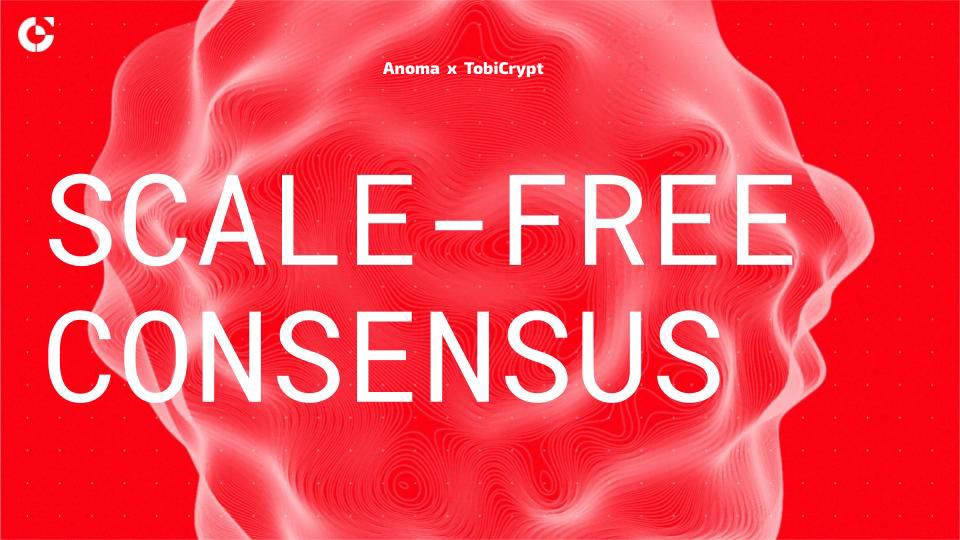[GUEST ACCESS MODE: Data is scrambled or limited to provide examples. Make requests using your API key to unlock full data. Check https://lunarcrush.ai/auth for authentication information.]  Tobiloba [@TobiCrypt](/creator/twitter/TobiCrypt) on x XXX followers Created: 2025-07-18 14:33:40 UTC UNDERSTANDING SCALE-FREE CONSENSUS anoma’s scale-free consensus is still one of the wildest concepts in this space. it isn’t just about scaling throughput, it’s about scaling freedom. most consensus systems scale by restricting what you can do: they limit state, enforce strict sequencing, or split the system into shards or domains. they scale by making you give up global shared state. anoma said nah. what if we could scale without sacrificing full shared state and privacy-preserving coordination? what if coordination at global scale didn’t need global consensus on every little thing? scale-free consensus does exactly that. instead of forcing the whole network to agree on everything, anoma uses intent gossip + intent-centric architecture to let only the relevant parties participate in the solving and settlement of intents. no need to hammer every message through a bottleneck. no need to make everyone sync stuff that has nothing to do with them. coordination becomes localized, but still composable. you can coordinate globally but only the subset of nodes involved in the coordination need to be in consensus. others can ignore it entirely. and because it’s privacy-first, coordination doesn’t leak info to irrelevant nodes. so the result? a consensus model that feels organic where growth doesn’t mean rigidity, and scale doesn’t mean centralization. scale-free consensus isn’t scaling the old model, it’s throwing it out. replacing it with something more natural for how coordination actually works in the real world. and honestly? that’s the only kind of scaling that truly makes sense for a world of intents. if you ever watched Demon Slayer, you know how some battles happen so fast, with so much coordination, it’s like time slows down for just the people in it while the rest of the world stays still. that’s scale-free consensus. fast, private, hyper-targeted coordination.  XXXXX engagements  **Related Topics** [anoma](/topic/anoma) [shards](/topic/shards) [Post Link](https://x.com/TobiCrypt/status/1946216807779516670)
[GUEST ACCESS MODE: Data is scrambled or limited to provide examples. Make requests using your API key to unlock full data. Check https://lunarcrush.ai/auth for authentication information.]
 Tobiloba @TobiCrypt on x XXX followers
Created: 2025-07-18 14:33:40 UTC
Tobiloba @TobiCrypt on x XXX followers
Created: 2025-07-18 14:33:40 UTC
UNDERSTANDING SCALE-FREE CONSENSUS
anoma’s scale-free consensus is still one of the wildest concepts in this space. it isn’t just about scaling throughput, it’s about scaling freedom.
most consensus systems scale by restricting what you can do: they limit state, enforce strict sequencing, or split the system into shards or domains. they scale by making you give up global shared state.
anoma said nah. what if we could scale without sacrificing full shared state and privacy-preserving coordination? what if coordination at global scale didn’t need global consensus on every little thing?
scale-free consensus does exactly that. instead of forcing the whole network to agree on everything, anoma uses intent gossip + intent-centric architecture to let only the relevant parties participate in the solving and settlement of intents.
no need to hammer every message through a bottleneck. no need to make everyone sync stuff that has nothing to do with them. coordination becomes localized, but still composable.
you can coordinate globally but only the subset of nodes involved in the coordination need to be in consensus. others can ignore it entirely.
and because it’s privacy-first, coordination doesn’t leak info to irrelevant nodes.
so the result? a consensus model that feels organic where growth doesn’t mean rigidity, and scale doesn’t mean centralization.
scale-free consensus isn’t scaling the old model, it’s throwing it out. replacing it with something more natural for how coordination actually works in the real world.
and honestly? that’s the only kind of scaling that truly makes sense for a world of intents.
if you ever watched Demon Slayer, you know how some battles happen so fast, with so much coordination, it’s like time slows down for just the people in it while the rest of the world stays still. that’s scale-free consensus. fast, private, hyper-targeted coordination.

XXXXX engagements